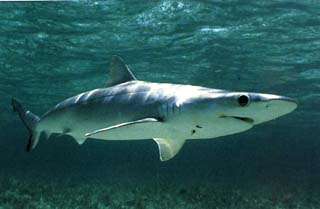Atlantic Sharpnose Shark

Common Name: Atlantic Sharpnose Shark
Scientific Name: Rhizoprionodon Terraenovae
Description
The Atlantic sharpnose shark, named for its long, pointed snout, is one of at least five shark species found in South Carolina estuaries (where rivers meet the sea). This predatory fish averages less than three feet in length and feeds mainly on shrimp, crabs, worms, and small fish.
Coloration
Grey to grey-brown with white ventral surface. Adults have small light (white) dots on body, white margins on pectoral fins and and dusky dorsal fin tips.
Distribution
Western North Atlantic: New Brunswick to Florida, Bahamas and Gulf of Mexico.
Biology
Abundant. Lives over continental shelf, mainly in shallow water (less than 30 ft) but has been found down to 900 ft. Tolerant to different salinities, and can be found in estuaries and river mouths. During winter months they migrate into deeper waters. Sharpnose sharks can form big schools of same sex and size.
Feeding
Small fishes, crustaceans and molluscs. Size: Average size between 2.5 to 3 ft, maximum total length about 4 ft.
Reproduction
Gives birth to live young (viviparous, with yolksac-placenta). Normally 4 to 6 pups per litter, although can vary from 1 to 7. Pups are born in unprotected nursery grounds. Fast growth, reaching maturity after 3 to 4 years with a size of 2 to 2.5 ft. (males) and 2.5 to 3 ft. (females).
Similar Species
None. This is the species locally called "sand sharks"
Population Status
Common
Danger to Humans
Harmless (although any species of captured shark can - and will try - to bite a careless angler). Newfoundland, Canada, to Argentina, including Gulf of Mexico and Caribbean Sea. Common in U.S. Northeast and mid-Atlantic.
 Deep Sea Crabs
Deep Sea Crabs